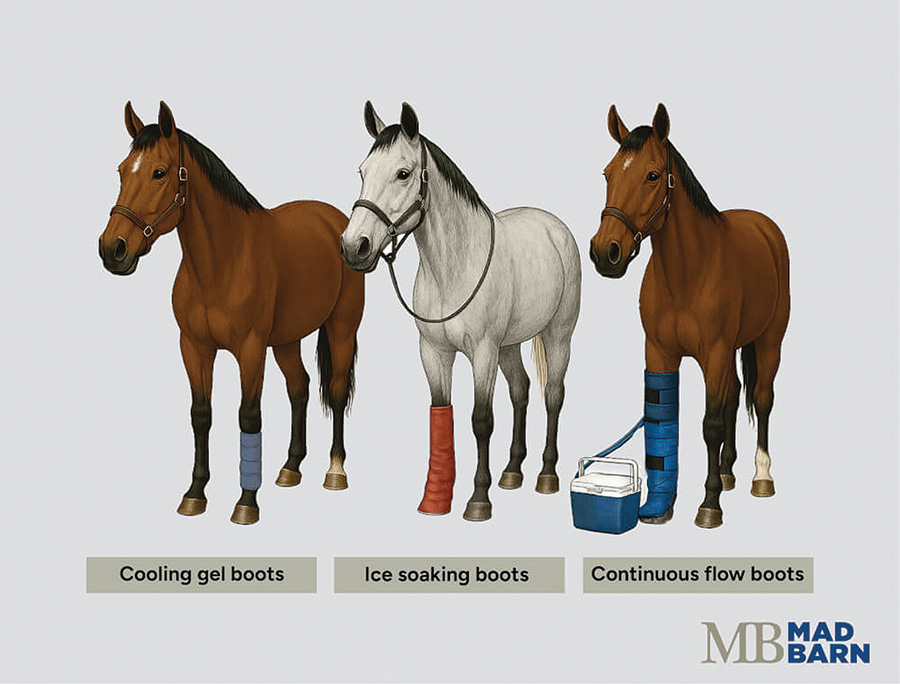
Ice boots are a form of cryotherapy (cold therapy). By lowering tissue temperature, cellular activity is slowed and blood vessels are constricted in the treatment area, which reduces inflammation and allows for effective healing.
As Canada’s leader in equine nutrition, Mad Barn thanks The Rider for featuring this story. To read the full version of the article, visit https://madbarn.com/ice-boots-for-horses/.
Ice boots are a useful and inexpensive tool for managing recovery in horses after exercise or injury. These specially-designed equine devices help cool the horse’s legs, providing relief from pain, inflammation, and swelling.

Ice Boots for Horses
Ice boots are a form of cryotherapy (cold therapy). By lowering tissue temperature, cellular activity is slowed and blood vessels are constricted in the treatment area, which reduces inflammation and allows for effective healing.
Ice Boot Uses
In equine care, ice boots are most commonly used for:
• Laminitis management and prevention
• Exercise recovery
• Injury rehabilitation
• Soft tissue injuries
Remember to always work with your veterinarian if your horse is showing signs of lameness or injury. Ice boots are not a substitute for medical care or pharmaceutical pain management.
Effects of Ice Boots
Although its exact mechanisms are still being studied, cryotherapy is believed to reduce inflammation, affect enzyme activity, and significantly decrease blood flow in the treatment area. The combined effect of lower temperature and reduced circulation is thought to trigger beneficial changes in the tissue.
Work with your veterinarian if your horse has pre-existing risk factors like vascular or circulation issues that may be contraindicated in cryotherapy.
Types of Ice Boots
The ice boot design is primarily divided into two categories:
• Sleeve-style: Slide over the horse’s leg like a sock. These provide a snug, continuous fit.
• Wrap-style: This style is secured around the leg using adjustable fasteners such as straps or Velcro®. This design allows for a customizable fit and targeted application of cooling.
The cooling mechanism used by these boots is classified as either:
• Wet: Uses water and/or ice. These boots are inexpensive and easy to use, but require additional ice and water to work.
• Dry: Uses cold-retaining materials such as gel-packs, beads, and capsules.
Some ice boots are designed to cycle water, ice, and other cooling solutions into the boot from an outside source with the use of a compressor. These systems are called continuous flow boots and are more expensive than traditional ice boots.
Some owners prefer this option because it allows them to customize their horse’s treatment solution. The drawback is that the horse must remain standing still while the boots are in use.

Illustration: Dr. Ana Mesa, PhD
How to Use Ice Boots for Horses
Different styles of ice boots may have slight variation in how they are used, but the basic steps for application are as follows:
1. Prepare the cold materials: The ice packs for your horse’s boots need to be preconditioned in the freezer. Boots that use ice instead require having a sufficient supply of ice on hand.
2. Prepare the boots: Depending on the style of boot, you may need to insert ice cubes or packs into the boot pockets before applying them to your horse. For sleeve-style boots, the ice and water are added after the horse is wearing the boots.
3. Position the boots: Place the prepared ice boots on the horse’s legs according to the manufacturer’s instructions. Ensure they cover the targeted areas. For front legs, position the boots around the cannon bone and below the knee. For hind legs, they are usually placed around the lower leg or hock area.
4. Secure the boots: When using wrap-style boots, secure them with the fasteners. Ensure the straps are secure, but not so tight that they restrict blood flow. When using a sleeve-style boot, lift the horse’s leg and pull the boot over the foot and all the way up until the hoof makes contact with the bottom of the boot. Fill the boot with ice and water to initiate treatment.
5. Monitor: Check the horse’s skin periodically for excessive redness or irritation. Discontinue therapy and call your veterinarian if adverse reactions occur.
6. Aftercare: Once the ice boots are removed, gently dry the area with a towel. Massaging the area after may promote circulation. Should the horse show signs of discomfort or sensitivity, reduce the frequency of use or consult with a veterinarian.
These are general instructions that apply to most cooling systems. Always follow the manufacturer instructions and guidance from your veterinarian for optimal effects.
 Sara Rice is a writer, researcher, anthropologist, and globetrotter from Canada. Sara graduated Summa Cum Laude from McMaster University with a Bachelor of Arts and holds a Master of Science from the University of Amsterdam. She is a science writer whose area of equine expertise includes the GI tract, common parasites, and disease prevention through management strategies. She is also a creative writer, researcher, traveller, pet owner, partner, and parent.
Sara Rice is a writer, researcher, anthropologist, and globetrotter from Canada. Sara graduated Summa Cum Laude from McMaster University with a Bachelor of Arts and holds a Master of Science from the University of Amsterdam. She is a science writer whose area of equine expertise includes the GI tract, common parasites, and disease prevention through management strategies. She is also a creative writer, researcher, traveller, pet owner, partner, and parent.
Source: MadBarn


